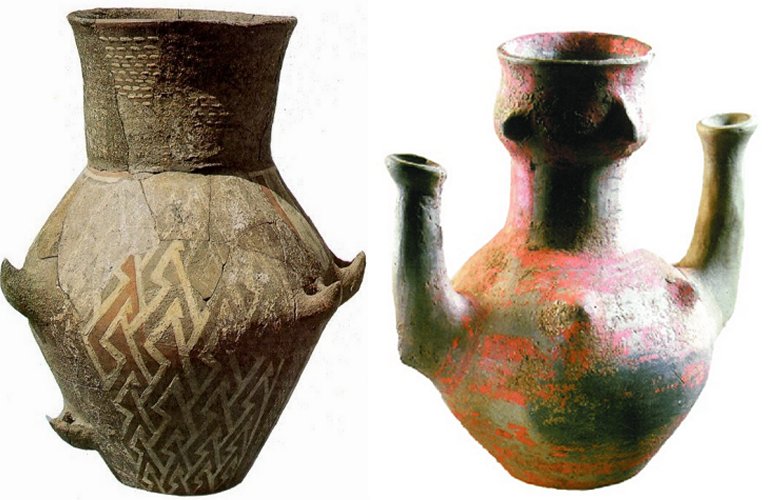Lengyel Culture Of Neolithic Europe Was Amazingly Sophisticated
A. Sutherland - AncientPages.com - The Lengyel culture that developed in southern Europe was initially linked to the site of Lengyel in Tolna county, in the southwestern part of Hungary.
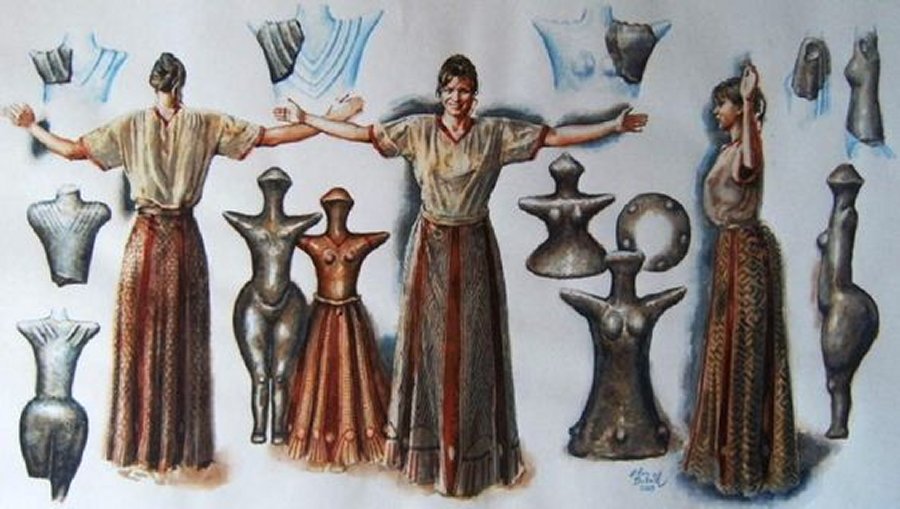 Lengyel culture traditions. source
Lengyel culture traditions. source
The Lengyel culture dates to ca. 5000 - 3400 BC, was the eastern successor to the Linear Ware culture. The settlements belonging to them were found in present-day Moravia (Czech Republic), Western Hungary, Western Slovakia, Southern Poland, and adjacent parts of Austria, Slovenia, and Croatia.
Small And Long Houses
People lived in open villages protected by ditches, and their houses were long rectangular or trapezoidal) multi-room buildings carved from clay, later also small rectangular or square pillar houses.
The society was engaged in agriculture, raising of animals like pigs, sheep and goats, hunting and fishing, cultivation of wheat, barley, and leguminous plants like lentils, peas.
Settlements of the Lengyel culture were large, widespread, and built on the river terrace, surrounded by V-shaped ditches and fences of buildings.
 Lengyel culture - A small dwelling model. Source
Lengyel culture - A small dwelling model. Source
For their protection, the people constructed defensive fortifications (often only on one side of the settlement).
'Roundels' And Ritual Activities
Early Lengyel culture was associated with circular earthworks of late Neolithic Europe known as (the 'roundels' or 'rondels'), where the ritual activities took place according to ancient traditions of these people.
The roundels (from 35 to 150 m in diameter) were considered their temples.
However, excavations carried out at many different sites of the Lengyel culture exposed the large enclosures that probably served only for ceremonial purposes because they lacked burials and pottery remains.
Not long ago, more than 130 roundels have been located in Europe, a third of them in Austria. The rest are in today's Hungary, Slovakia, Poland, the Czech Republic, and Germany. Currently, there are now ten known roundels, which are considered the oldest examples of monumental architecture in Europe.
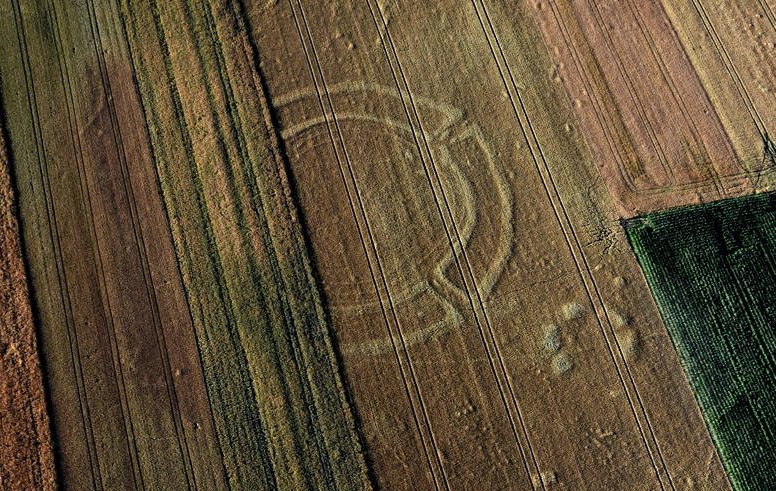 Aerial image of another Neolithic rondel enclosure located at Drzemlikowice, SW Poland. source
Aerial image of another Neolithic rondel enclosure located at Drzemlikowice, SW Poland. source
"A ditch that had four gates oriented in the cardinal directions formed the outer boundary of the monument; the enclosed area measured 145 by 125 meters. A roundel in the center of the ditch measured about 50 meters in diameter. It consisted of several poles set inside another ditch, and each of them opened to the four directions.
Excavations revealed an abundance of ritual evidence. They uncovered 314 early Lengyel-style figurines, inside the central roundel and the rest either outside of it or in the outer ditch. 1
The findings also included a sculpture of a goddess about forty centimeters tall, and ceramic vases painted in red, yellow, and white colors, and a human skull.
Another pit, on the other hand, contained a skeleton of a young woman buried in a contracted position. Her skull had been removed and buried under the wall of a grain pit. The Lengyel religious traditions are not precisely known; therefore, it is hard to say if the woman was buried in honor after natural death or ritually sacrificed during harvest rites.
Left: Lengyel culture pottery. source; Right: Anthropomorphic vessel from Svodín, dated to the Lengyel culture (after Nemejcová-Pavúková 1998, 65). source
The Lengyel pottery - found in a great variety of forms - includes bowls, small amphorae, zoomorphic and anthropomorphic vessels, pedestalled bowls, and ceramic figurines.
Early ceramics bear signs of painting with white, red, and yellow paints; otherwise, pottery was decorated with paintings or carved ornaments.
Body Parts Were Sometimes Separated
The deceased were buried in various ways. In the early period, the dead were not buried in the cemetery; this tradition appeared later. Sometimes their body parts (arms, legs, head) were separated and placed next to them, along with a boar or pig's lower jaw or fangs.
Triangular and trapezoidal burial mounds were found in southern Poland.
According to the Lengyel burial tradition, the group graves were located in large cemeteries or within settlements. Their equipment included vessels, stone tools, decorations, products made of bone, horn (horn axes), jewelry (bone beads, and beautiful geometrically decorated bone bracelets) and copper.
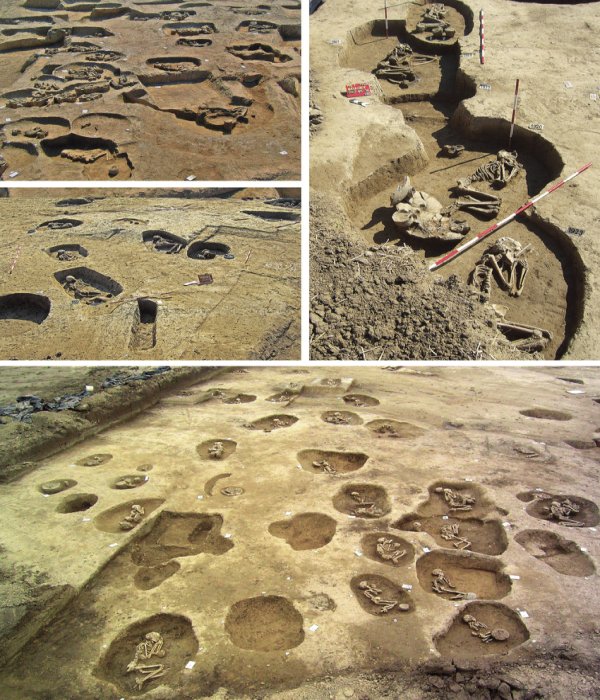 Lengyel culture grave groups. The Neolithic settlement of Alsónyék reached its greatest extent during the Late Neolithic Lengyel period. Nearly 9000 features, including postholes associated with 123 houses, pits and pit complexes, and ca. 2300 burials, could be assigned to it. The traces of Lengyel settlement and burials were found over the entire excavated area. Image credit: Alex Bayliss/ResearchGate
Lengyel culture grave groups. The Neolithic settlement of Alsónyék reached its greatest extent during the Late Neolithic Lengyel period. Nearly 9000 features, including postholes associated with 123 houses, pits and pit complexes, and ca. 2300 burials, could be assigned to it. The traces of Lengyel settlement and burials were found over the entire excavated area. Image credit: Alex Bayliss/ResearchGate
"Men were buried with tools and other artifacts suggesting trades and mining, like stone axes and hammer-axes made from antler and with nodules of flint and obsidian. The latter were mined in the nearby Carpathian Mountains.
Artifacts found with women also show their occupations. Some women's graves contained stone tools for hand-grinding and baking.
See also:
Lemko People – European Minority That Lost Their Homeland And Still Live In Exile
Who Were The Goths And Where Did They Come From?
"Tool kits for decorating pottery were found in several graves. But the types of artifacts found in male graves versus female graves are not subject to a strict division of labor." 1
In some cemeteries, archaeologists found quern stones, axes, chisels, or copper and shell jewelry in both male and female graves.
Women played an important role at home and in the religious traditions of the society. Many luxurious grave goods were unearthed in women's and young girl's tombs.
The Lengyel culture was not a complex society. Yet, they possessed an understanding of geometry, which can be seen in the culture's pottery remains, geometrically decorated bracelets, and the way they built their roundels and ditches as well.
Written by – A. Sutherland - AncientPages.com Senior Staff Writer
Copyright © AncientPages.com All rights reserved. This material may not be published, broadcast, rewritten or redistributed in whole or part without the express written permission of AncientPages.com
Expand for referencesJ. P. Mallory, Douglas Q. Adams, Encyclopedia of Indo-European Culture
- Marija Gimbutas. The Living Goddesses
More From Ancient Pages
-
 On This Day In History: “Man In The Iron Mask” Died In The Bastille, Paris, France – On Nov 19, 1703
News | Nov 19, 2016
On This Day In History: “Man In The Iron Mask” Died In The Bastille, Paris, France – On Nov 19, 1703
News | Nov 19, 2016 -
 Shu: Egyptian God Of Air, Symbol Of Life-Giving Breath And The One Who Separates Heaven From Earth
Egyptian Mythology | Oct 23, 2020
Shu: Egyptian God Of Air, Symbol Of Life-Giving Breath And The One Who Separates Heaven From Earth
Egyptian Mythology | Oct 23, 2020 -
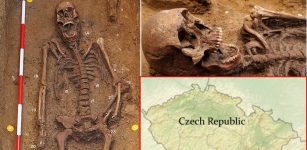 Young Warrior’s Grave Dated To A Sixth Century Unearthed At Langobard Necropolis In Czech Republic
Archaeology | Jul 5, 2022
Young Warrior’s Grave Dated To A Sixth Century Unearthed At Langobard Necropolis In Czech Republic
Archaeology | Jul 5, 2022 -
 Wanyūdō The Soultaker – Fearsome Yōkai In Japanese Mythology
Featured Stories | Nov 22, 2017
Wanyūdō The Soultaker – Fearsome Yōkai In Japanese Mythology
Featured Stories | Nov 22, 2017 -
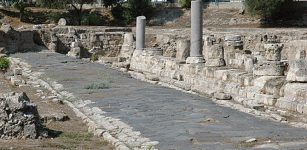 Biblical City Of Tarsus: Excavations Reveal Its Secrets From Paul the Apostle’s Times
Archaeology | Jan 4, 2016
Biblical City Of Tarsus: Excavations Reveal Its Secrets From Paul the Apostle’s Times
Archaeology | Jan 4, 2016 -
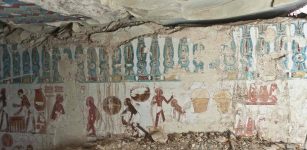 An Intact 4,000-Year-Old Burial Chamber Found In Aswan
Archaeology | Mar 28, 2017
An Intact 4,000-Year-Old Burial Chamber Found In Aswan
Archaeology | Mar 28, 2017 -
 Legend Of Tarenyawagon Who Came From The Heavens And Ascended To The Stars In His Fast Flying Shining Canoe
Featured Stories | Feb 25, 2019
Legend Of Tarenyawagon Who Came From The Heavens And Ascended To The Stars In His Fast Flying Shining Canoe
Featured Stories | Feb 25, 2019 -
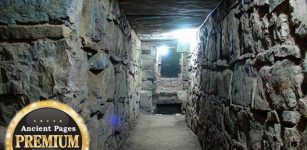 Secret Ancient Subterranean Tunnels And Caverns Across America: Who Or What Were Our Ancestors Hiding From?
Civilizations | Oct 4, 2015
Secret Ancient Subterranean Tunnels And Caverns Across America: Who Or What Were Our Ancestors Hiding From?
Civilizations | Oct 4, 2015 -
 Political Debates In Ancient Rome: Great Harshness, Personal Attacks And Unpleasant Atmosphere
Archaeology | Aug 29, 2018
Political Debates In Ancient Rome: Great Harshness, Personal Attacks And Unpleasant Atmosphere
Archaeology | Aug 29, 2018 -
 Mystery Of The Lost Cahuenga Pass Treasure: Baffling Unexpected Deaths Caused By A Curse Or Natural Causes?
Featured Stories | Nov 2, 2018
Mystery Of The Lost Cahuenga Pass Treasure: Baffling Unexpected Deaths Caused By A Curse Or Natural Causes?
Featured Stories | Nov 2, 2018 -
 Towering Sacred Mt. Fuji: Abode Of The Immortals In Ancient Japanese Beliefs
Featured Stories | Feb 23, 2017
Towering Sacred Mt. Fuji: Abode Of The Immortals In Ancient Japanese Beliefs
Featured Stories | Feb 23, 2017 -
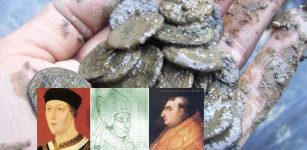 15th Century Cooking Pot With 500 Silver And Gold Coins Unearthed In Vianen, Netherlands
Archaeology | Mar 6, 2018
15th Century Cooking Pot With 500 Silver And Gold Coins Unearthed In Vianen, Netherlands
Archaeology | Mar 6, 2018 -
 Advanced Method That Can Solve Puzzle Of Rock Engravings Studied In Timna Park
Archaeology | Jul 13, 2024
Advanced Method That Can Solve Puzzle Of Rock Engravings Studied In Timna Park
Archaeology | Jul 13, 2024 -
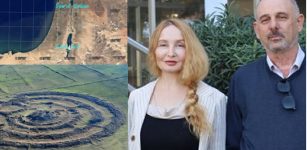 Mystery In The Stones: Rujm El-Hiri (Wheel Of Ghosts) Was Not An Ancient Observatory – So Why Was It Built? – New Study
Archaeology | Jan 2, 2025
Mystery In The Stones: Rujm El-Hiri (Wheel Of Ghosts) Was Not An Ancient Observatory – So Why Was It Built? – New Study
Archaeology | Jan 2, 2025 -
 What Happened To The Homo Sapiens In The Thar Desert When They Encountered The Indian Monsoon System
Archaeology | Oct 5, 2021
What Happened To The Homo Sapiens In The Thar Desert When They Encountered The Indian Monsoon System
Archaeology | Oct 5, 2021 -
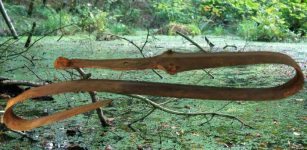 Rare Bronze Age Sacrificial Offerings, Including A Bent Sword Found In A Bog Near Veksø, Denmark
Archaeology | Dec 3, 2024
Rare Bronze Age Sacrificial Offerings, Including A Bent Sword Found In A Bog Near Veksø, Denmark
Archaeology | Dec 3, 2024 -
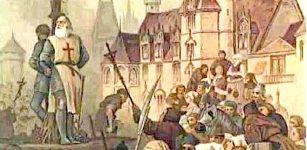 On This Day In History: Knights Templars’ Jacques de Molay Burned At The Stake – On Mar 18, 1314
News | Mar 18, 2017
On This Day In History: Knights Templars’ Jacques de Molay Burned At The Stake – On Mar 18, 1314
News | Mar 18, 2017 -
 Unexplained Ancient Wars In America – Strange Physical Evidence – Part 2
Featured Stories | Oct 4, 2020
Unexplained Ancient Wars In America – Strange Physical Evidence – Part 2
Featured Stories | Oct 4, 2020 -
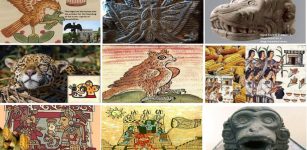 10 Aztec Symbols Explained
Ancient Symbols | Mar 20, 2018
10 Aztec Symbols Explained
Ancient Symbols | Mar 20, 2018 -
 Mama Cocha – Inca Goddess Of The Sea With Strong Connection To Lake Titicaca, Peru
Featured Stories | May 26, 2020
Mama Cocha – Inca Goddess Of The Sea With Strong Connection To Lake Titicaca, Peru
Featured Stories | May 26, 2020

